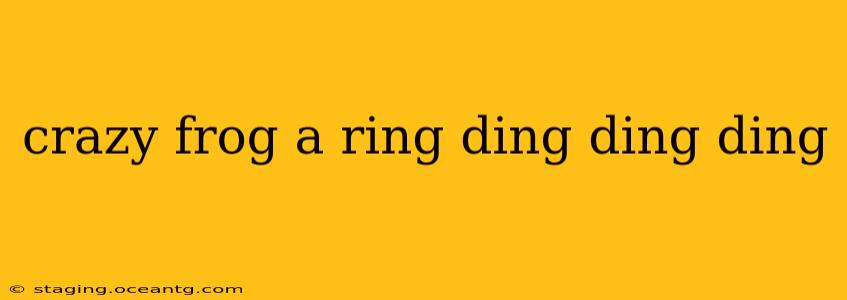Crazy Frog: A Ring Ding Ding Ding Down Memory Lane
The Crazy Frog. That name alone probably conjures up a specific, slightly annoying, yet undeniably catchy ringtone in your head. For many, it’s a blast from the past, a relic of the early 2000s mobile phone era. But what exactly is the Crazy Frog, and how did this bizarre animated amphibian become a global phenomenon? Let's dive into the surprisingly rich history of this digital icon.
What is the Crazy Frog?
The Crazy Frog, officially known as The Annoying Thing (a name much less catchy, thankfully!), isn't just one thing. It's a multimedia character, a brand, and a cultural icon built around a series of animated shorts featuring a bizarre, cartoonish frog (or perhaps a toad?) performing motorcycling stunts and other antics, usually accompanied by its signature "Ring Ding Ding Ding" sound. This sound is actually a remixed version of a 1997 song called "Axel F" by Harold Faltermeyer, made famous by the movie Beverly Hills Cop.
How did the Crazy Frog become so popular?
The Crazy Frog's rise to fame is a fascinating case study in viral marketing. It started in 2003 with a short animated clip. The seemingly nonsensical nature of the animation, coupled with the undeniably catchy and repetitive "Axel F" remix, proved incredibly infectious. The clips were initially distributed online, rapidly spreading via early file-sharing networks and early social media platforms. The simplistic animation combined with the catchy tune was the perfect recipe for virality. The ringtone, available for download on various mobile networks, cemented its status as an inescapable pop culture moment.
Who created the Crazy Frog?
The original animation was created by Swedish artist Erik Wernquist for his company The Janson Media. However, the global marketing and branding of the Crazy Frog were spearheaded by The Company, a digital marketing agency. The success was a blend of creative animation, a memorable sound, and clever marketing leveraging the early adoption of mobile phone technology and internet culture.
What happened to the Crazy Frog?
While its peak popularity was undoubtedly in the mid-2000s, the Crazy Frog hasn’t completely disappeared. Its enduring legacy can be seen in occasional reappearances in online media, new animation releases, and merchandise. Though not as ubiquitous as it once was, it remains a recognizable figure for those who remember its reign as king of the ringtone world. The Crazy Frog continues to represent a period of early mobile technology and online virality, reminding us of how quickly a seemingly simple animation and catchy tune can become a global phenomenon.
Why was the Crazy Frog so annoying?
The repetitive nature of the “Ring Ding Ding Ding” sound, combined with the slightly jarring animation style, undeniably contributed to its reputation as "annoying." This very annoyance, however, fuelled its popularity in a paradoxical way. It became a symbol of that slightly irritating yet irresistible tune that many couldn't help but find themselves humming along to, even while simultaneously complaining about its incessant repetition. The intense memorability was partially a function of its very "annoyance."
Is the Crazy Frog still relevant today?
While it’s no longer a top trending topic, the Crazy Frog enjoys a consistent level of recognition, largely due to nostalgia. It resurfaces occasionally online, reminding older generations of its impact and introducing it to younger ones. Its continued presence in online culture demonstrates the long-lasting effect of early viral marketing and its place as an icon of a specific moment in mobile phone history. It stands as a reminder of how quickly memes and internet sensations can spread and achieve lasting (if sometimes ironic) cultural significance.
